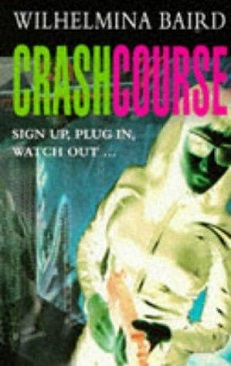
Crashcourse
Wilhelmina Baird
277 pages
published in 1993
Wilhelmina Baird is an interesting writer: wrote some short science fiction at the dawn of the New Wave (as Kathleen James), then returned in 1993 with this, a cyberpunk inspired novel with overtones of the sort of fifties satirical sf Pohl and Kornbluth wrote. She wrote three more novels, two sequels to this, then disappeared. She's obscure enough not to even have a Wikipedia entry, so it's unclear if she stopped writing or just couldn't get published anymore. I vaguely remember that her second novel, Clipjoint, was hailed as a minor classic when it came out, but that's all I knew of her writing when I first got this.
In the world of Crashcourse the population is divided in a small ruling class of Aris, slightly more Techs and Arts to serve and entertain them, with the vast mass of people being unemployed umps. Cass, Moke and Dosh are three of them, trying to earn enough (illicit) money to get off Earth, Cass as thief, Moke as artist and Dosh as whore. Caught up in a love triangle, with Cass loving Dosh who loves Moke who loves Cass, only wanting to leave if all three of them can leave together. That is, until Dosh is roughed up once too many by one of his clients and temptation comes calling in the form of an Aris with a film proposal.
As Cass is all too well aware, such a film is little more than a legalised snuff movie, where some hapless umps are enticed to sign their lives away in return for a shot at the kind of money that can get them off Earth and into the good life. Meanwhile the audience doesn't just see them get killed, but actually feels the emotions of the leading actor or actress in a movie. It used to be that the film company didn't inform their stars that they were on camera, but that had been outlawed -- not that this made the films necessarily safer.
Cass -- short for Cassandra, as what else could it be -- warns against taking the contract, but Dosh is obsessed by becoming a proper actor and sees this as his real break, while Moke is happy enough to go along if only to stop all three of them from staying stuck in their old routines, with no real hope of making it off Earth. Once they have signed the contract, things move fast. Cass and Dosh are caught in a runaway funfair ride, while Moke gets an invitation from a serious art collector to talk about his sculptures and to top it all off, they rescue a young teenage girl from a gang rape.
To be honest, the plot flowed in a familiar pattern from there on out, where of course the "rescue" is all part of the film and the art collector, who the protagonists all dismiss as too obvious a put-on, turns out be genuine. Just as predictable, Cass and her friends, with a little bit of help from the local gangster in love with her, plot to turn the tables on the film company and succeed, but at the cost of the life of one of them.
The plot is therefore slightly pedestrian, while the background is, as said, clearly influenced by cyberpunk, but with a fifties sheen to it. It's not quite over the top enough to rank with something like The Space Merchants, but it has some of the same elements. A world rigidly divided in haves and have nots, where the vast mass of people have nothing to do but engage in mindless entertainment and crime, while their rulers in turn amuse themselves with them. There's some use of the usual computer hocus pocus you'd expect in cyberpunk, but it's marginal; this story could've easily been told without it.
Crashcourse, even if predictable, kept me entertained, in large part due to the way Wilhelmina Baird writes Cass, as a self aware, sometimes funny, tough but vulnerable woman, somebody who goes along with a harebrained scheme against her better instincts, out of love. The love triangle between Cass, Dosh and Moke is only sketched, but comes across as warm and real, a far cry from some of the more regretable cyberpunk cliches.
Webpage created 16-12-2013, last updated 28-12-2013.